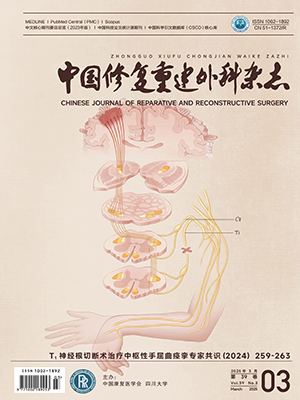Objective To investigate the efficacy and safety of over-bending rod reduction and fixation technique via posterior approach in the treatment of unstable fresh thoracolumbar burst fracture.Methods A clinical data of 27 patients with unstable fresh thoracolumbar burst fracture, who were met the inclusive criteria and admitted between January 2018 and October 2019, was retrospectively analyzed. There were 15 males and 12 females with an average age of 41.8 years (range, 26-64 years). The fractures were caused by falling from height in 14 cases, traffic accident in 8 cases, and crushing by a heavy objective in 5 cases. The interval between injury and operation was 1-7 days (mean, 3.2 days). The injured fracture was located at T10 in 1 case, T11 in 3 cases, T12 in 6 cases, L1 in 7 cases, L2 in 7 cases, and L3 in 3 cases. According to AO classification, there were 11 cases of type A3, 7 cases of type B, and 9 cases of type C. Neurological function was rated as grade A in 3 cases, grade B in 7 cases, grade C in 5 cases, and grade D in 12 cases according to the American Spinal Injury Association (ASIA) grading. All cases were treated by over-bending rod reduction and fixation technique via posterior approach, and 16 cases were combined with limited fenestration decompression. The evaluation indicators consisted of operation time, intraoperative blood loss, the compression ratio of the anterior vertebral height, the invasion rate of the injured vertebra into the spinal canal, the Cobb angle of segmental kyphosis, visual analogue scale (VAS) score, and Oswestry Disability Index (ODI).Results The operation time was 67-128 minutes (mean, 81.6 minutes), and the intraoperative blood loss was 105-295 mL (mean, 210 mL). All patients were followed up 12-23 months (mean, 17.2 months). A total of 178 pedicle screws were implanted during operation, and the accuracy of the implantation was 98.9% (176/178). The compression ratios of the anterior vertebral height at the early postoperatively and last follow-up were significantly increased when compared with preoperative one (P<0.05), and the invasion rate of the injured vertebra into the spinal canal, Cobb angle, VAS score, and ODI were significantly lower than those preoperatively (P<0.05). Except that the ODI at last follow-up was significantly lower than that of the early postoperative period (P<0.05), there was no significant difference between the last follow-up and the early postoperative period for other indicators (P>0.05). At last follow-up, the neurological function was rated as grade A in 1 case, grade B in 2 cases, grade C in 4 cases, grade D in 9 cases, and grade E in 11 cases according to the ASIA grading, showing significant difference when compared with that before operation (Z=–3.446, P=0.001).Conclusion Over-bending rod reduction and fixation technique can effectively restore vertebral height, reset the invaded vertebral block, and selectively perform limited decompression and posterolateral bone grafting to ensure the completeness of intravertebral decompression and stability, which is one of the effective methods to treat unstable fresh thoracolumbar burst vertebral fracture.
Citation:
LI Yuwei, WANG Haijiao, CUI Wei, ZHOU Peng, ZHAO Shixin. Treatment of unstable fresh thoracolumbar burst fracture by over-bending rod reduction and fixation technique via posterior approach. Chinese Journal of Reparative and Reconstructive Surgery, 2021, 35(4): 458-463. doi: 10.7507/1002-1892.202011063
Copy
Copyright © the editorial department of Chinese Journal of Reparative and Reconstructive Surgery of West China Medical Publisher. All rights reserved




